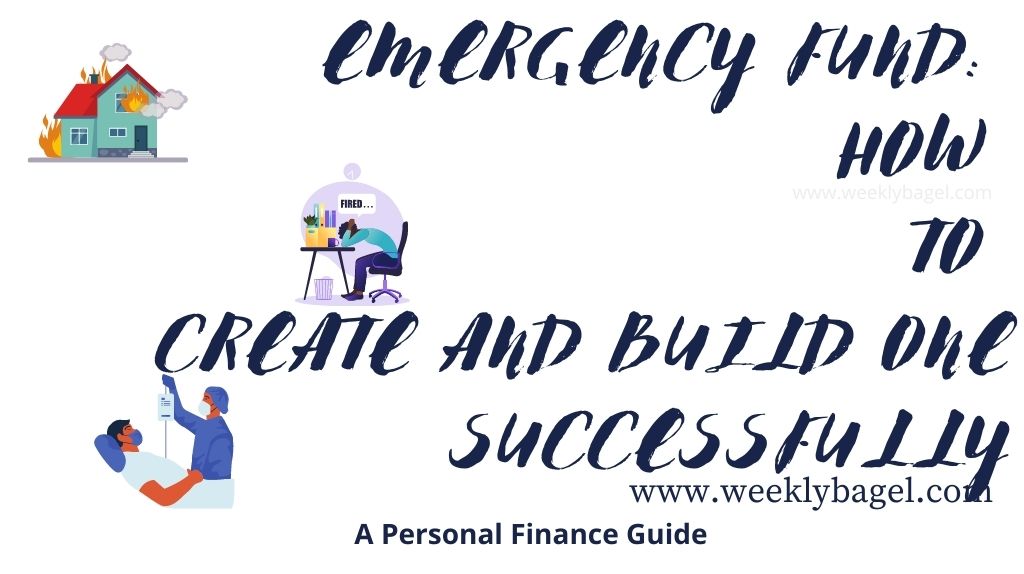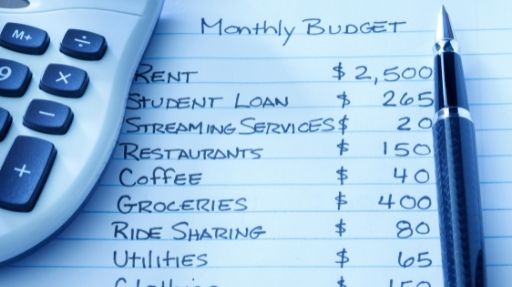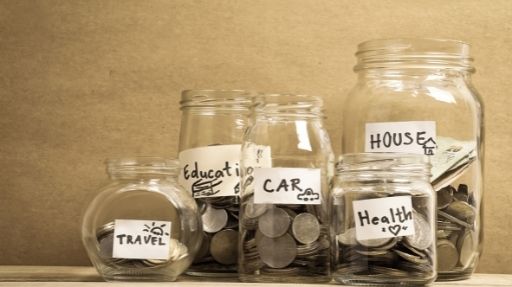An unexpected life changing phenomena like the Covid-19 pandemic, has proven the necessity of an emergency fund. Between September 15th to October 11th 2021, 9% of American adults did not have enough to eat as a result of financial emergency. This is according to a research by the Center On Budget and Policy Priorities to ascertain the economic effect of the pandemic on Americans.
By the way, 9% of American adults is the equivalence of 20 million people. And, why must I mention this to you?
I mention it to emphasize on the unpredictability of life. Without a good emergency fund, it is easy to be a victim of unforeseen financial emergencies. This is whether it is a sudden job loss, natural disaster, health deterioration, pandemic, property repairs, death or other life changing events.

Creating an emergency fund should be a top priority for every working class adult. This is because it ensures you are not immediately destabilized by an unexpected financial emergency situations.
How Does An Emergency Fund Work?
What is an emergency fund, dear reader?
It is a savings fund you set aside monthly in case of unexpected money emergency situations. This fund is different from your regular savings account. You can use your savings account, but you never touch the emergency fund until a dire emergency situation.
Want to know the best part?
You get to define the emergencies you are saving for. This is based on your monthly needs. Here is an example:
If your monthly necessities cost you $1500, then your emergency fund requires that you save exactly that amount. This is to maintain your basic necessities in case of a money emergency situation.
How To Build An Emergency Fund Successfully
To start and build an emergency fund, you need an income. This is because you cannot save money without money coming in. Once you have begun to earn money, here are how to set up an emergency fund.
1. Take Your Monthly Income and Expenses Into Account
Before putting money aside for emergency, you have to take your monthly income and expenses into account. Create a table of your necessary monthly expenses. Then, subtract net expenses from your after-tax income.
Whatever remains, is how much you may be able to put aside in savings and emergency fund. Further, here is how to limit expenses while saving for emergency fund.
How To Manage Monthly Expenses While Building An Emergency Fund
i. Use A Monthly Budget

A monthly budget ensures you do not spend more than necessary. It ensures you live within your means. Therefore, saving money monthly.
You can channel this money into your emergency savings fund. My article- How to Create a Personal Monthly Budget For Yourself, will help you set up a good monthly budget. Check it out.
ii. End Your Newspaper Delivery Subscription
Have you gone out lately to residential areas?
Houses are littered with unread newspapers. The worst part of this plague is the paper newspapers subscribers barely pick them up, until they are soaked in rain. If you are one of the newspaper subscribers, here is what I have to say to you.
You can browse the Internet for news for free and save $8 to $30 monthly. According to The Pricer Organization, newspaper subscription can cost anywhere from $8 to $30 monthly. This is how much you can contribute to your emergency fund, if you end your newspaper subscription today.
iii. Curb Your Multiple Media Subscriptions
To limit your monthly expenses while building an emergency fund, you do not need mutiple streaming subscriptions. There is no reason to subscribe to Amazon prime, Hulu, Vudu, Netflix, HBO Max and Cable simultaneously. Undoubtedly, these streaming services cost money monthly.
Hence, having these multiple media subscription can run you up to a $100 monthly. While this may not sound much to you, $100 monthly is equivalent to $1200 annually. This is an amount which could make a difference in your emergency fund.
Finally, I am not asking you not to have an online streaming service. No, it is not my message here. All I am saying is each streaming service has movies the others have. So, you can save a lot of money subscribing to one rather than maintaining an array of streaming service subscriptions.
iv. Save On Daily Coffee
If you are a daily consumer of coffee, it can take away money meant for financial emergency savings. To divert daily coffee expenses into your emergency fund, here are two ways you can go about it.
Firstly, you can go for cheap coffee rather than expensive brand names. By brand coffees, I refer to Starbucks and such. Especially, brand coffees which cost you +$3.50 per cup.
Secondly, you can start making your own coffee. Then, carry it in a warm flask to keep it warm for you to drink. This decision can save you up to $69 to $105 in daily coffee expenses every monthly.

Finally, to learn more ways to save on coffee expenses monthly, read my article on how to save on coffee. It will help limit your daily coffee expenses to about $15 monthly. And, that is not bad at all.
V. Avoid Buying Bottle Water In Fast-Foods and Restaurants
Have you observed a pack of 28 bottle water costs about $3.61 in HEB or Walmart, while a single bottle water costs somewhere around +$1.00?
If you are in the habit of buying bottle water from fast-food or gas stations, you may be spending a lot monthly. This is why it is important to buy your water in bulk, so you can avoid drinking water expenses. And, contribute to your emergency fund.
Here are other grocery bill hack to help you save save on drinking water. I use these to minimize my drinking water expense and maximize my emergency savings contribution. With that said, here is the second step on how to build an emergency fund.
2. Save A Percentage of Your Income
Now you have figured out ways to limit your monthly expenses, you can make use of your remaining monthly income. You can start by saving a percentage of your monthly income after necessary expenses. The percentage should be used to start an emergency fund.
Here are two ways to go about it.
If you bring home $1500 after tax and your necessary monthly expenses are $1300, you can save $100 as an emergency money. Keep $50 out of the remaining $100 in your regular savings account. Then, use the other $50 for miscellaneous expenses.
To elaborate, a year of doing this could result in $1200 in emergency money savings. Also, you will save $600 in regular savings. To simplify, the $1200 is gotten from $100 multiple by 12 months. The $600 is gotten from $50 multiplied by 12 months.
The second way to go about starting an emergency fund is to save 10% of your after-tax income, then budget your month with the remaining balance. Using the above income example, you will save 10% of $1500 which is $150. Then, budget your necessary monthly expenses with $1350.
As usual, the $150 will go into your savings meant for money emergency. This will add up to $1800 annually. Not bad, eh?
3. Have More than One Income Streams
As a young working class adult, your income is expected to go into bills. This is especially if your age bracket is between 18 and 25 years old. The Metropolitan Policy Program at Brookings found in a research that 53 million Americans earn low-wages. Out of those 53 million low income earners, young working class adults make up 24%.
And, they make a median annual salary of $17, 950. See every college student or working class adult should have an emergency fund?
Without it, a sudden catastrophe can destabilize your life. I am talking about miserable times ahead without such savings. It has happened to me. This is why I am making you aware of the need for multiple sources of income in case of a low wage.
Having more than one income streams, does not necessarily mean starting a business. It can be another job, say a part-time job. Oh yes- it is possible to have more than one job to have extra cash flow. Here is what you can do.
You can work part-time driving for service companies. By service companies here, I refer to delivery jobs. Two notable examples of such flexible part-time jobs are Door Dash and Amazon Flex delivery services. Besides this kind of jobs, some companies have part-time positions which can add a few hundred dollars biweekly to your monthly income.
When your full time job handles your necessary monthly expenses, you can divert the second income into your emergency fund and savings accounts. At the end of a twelve month period, you will see significant change in your savings accounts.
4. Set Up Automatic Savings Contribution Into Your Emergency Fund

Once you start making enough to save some money, set up automatic savings contribution. An automatic savings contribution is a deduction made on your paychecks and contributed to your savings. There are two ways you can set this up.
Firstly, you can have your employer contribute certain percentage of your income into a specific savings account. You let them know to do this, during direct paycheck deposit request. On some employers’ paperwork, they give you a choice to set aside a certain percentage to be paid into a specific savings account.
In this case, you will add the savings account you want to use for emergency funds.
Secondly, you can let your bank do it for you. Your bank can help you set aside money from one aspect of your bank account to another every month. For example, money can be transferred from checking to savings.
I recommend talking to your employer and your bank first to see whether they offer the service. Some banks have some savings account for emergency funds. Usually, such savings accounts have bonus. So, talk to your bank for recommended emergency savings account.
5. Raise Money By Selling Your Used Stuff
It is part of our consumer culture to buy things we barely use. And, leave them sitting around.
I did it. My friends did it. Hell, my neighbors’ backyards and garages are filled with used items worth a few thousands. I am talking about electronics of different models and ages, clothings, books and other marketable items.
It is the hallmark of our consumer culture, is it not?
Well, you may not have a garage or backyard full of marketable used products. But, you could dig around your living abode to see whether you have items no longer in use. These items may include used clothes, shoes, electronics or books. Then, put them up for sale.

Where to sale them, my dear reader?
There are tens of online markets for these used things nowadays. Online markets like Mercari, OfferUp and Posh are willing to take them off your hands. In fact, I used Mercari to generate about $700 in 2018 selling used games. I bought used Nintendo Games on OfferUp for tens of dollars and sold them on Mercari at market prices!
It was fun. I would still be doing it, if I had the time. Oh well, there goes my secret. You can do it too.
Finally, use the revenue to build your emergency savings fund. You would be surprised the amount of money you can raise selling things you no longer need.
How much should you have in your emergency fund?
While no amount is too much for an emergency fund, your savings should be able to take care of your monthly necessities for at least a month. This is in the case of emergency, where you are unable to work. Here is what I mean.
Prior to creating the contingency fund, you should know how much your monthly necessities expenses are. Then, try to save an amount every month to equal at least a month’s worth of such expenses. For example:
Say your monthly expenses are $1500, then you need to save in a way which will raise this amount. You could be saving $150 monthly or less to do it over some months. This is especially when you are a low income earner. I already explained how to do this in Step #2.
To be safe though, I recommend six months worth of savings in your contingency fund. An emergency situation like the Covid-19 pandemic has shown us the importance of having such amount on standby. Such a fund can carry you for awhile, until you can start earning an income again.
Is it possible to save six months of your monthly expenses for contingencies on low income, good reader?
Yes, it is. If you are willing to put in the work, you can do it on low income. I explained how you can do it on Step #3.
To summarize, creating an emergency fund depends greatly on your ability to curb your monthly expenses in order to save. As a previous low income young adult, I can tell you it is very possible to save up to +$1000 annually for contingency situations. You just have to try it.




 Who Qualifies For Student Loan Forgiveness After College
Who Qualifies For Student Loan Forgiveness After College